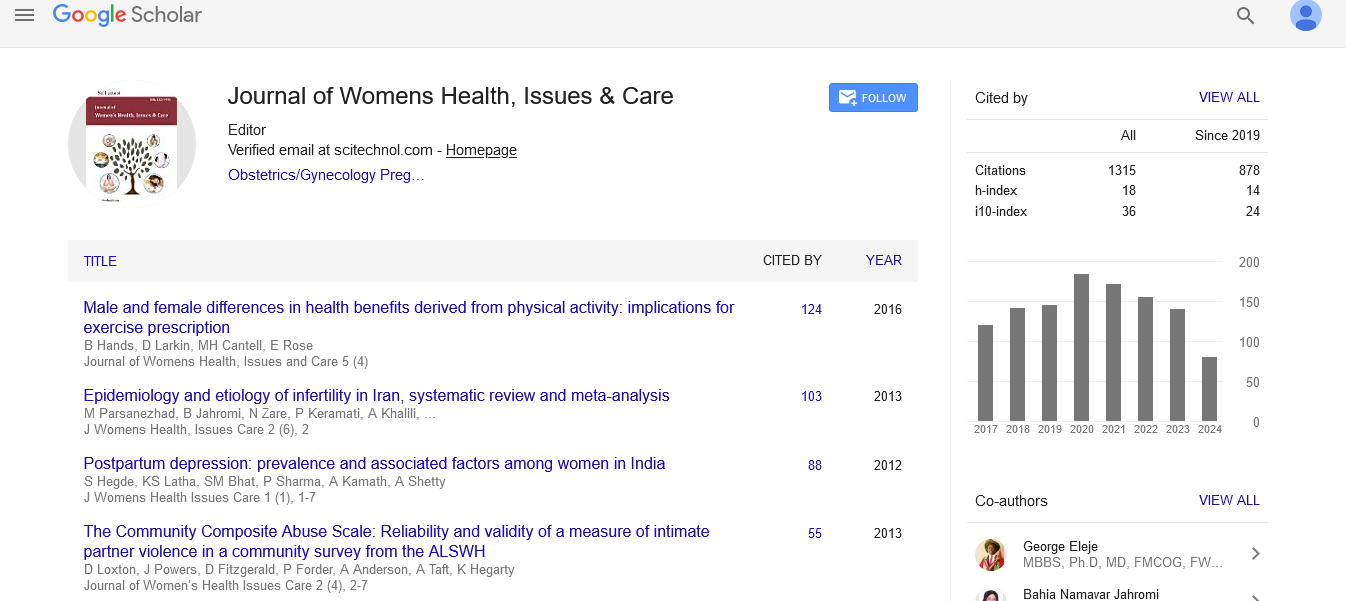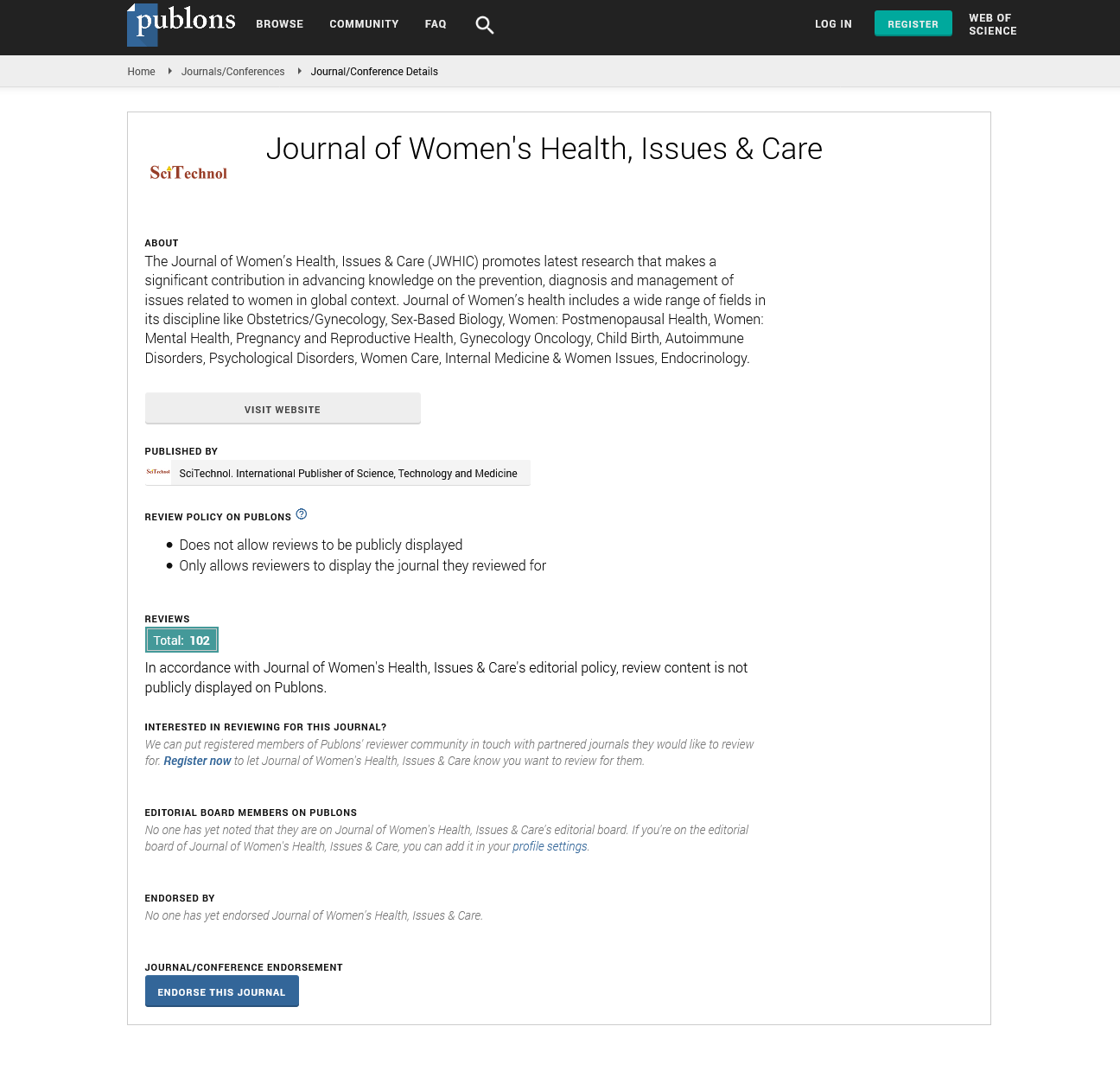Short Communication, J Womens Health Vol: 13 Issue: 4
The Connection between Pelvic Inflammatory Disease and Infertility in Women: Insights from STI Research
Mathilda Ozcan*
1Department of Obstetrics and Gynecology, Wright State University, Dayton, USA
*Corresponding Author: Mathilda Ozcan,
Department of Obstetrics and Gynecology,
Wright State University, Dayton, USA
E-mail: hunson__braswell@gmail.com
Received date: 23 July, 2024, Manuscript No. JWHIC-24-150194;
Editor assigned date: 25 July, 2024, PreQC No. JWHIC-24-150194 (PQ);
Reviewed date: 08 August, 2024, QC No. JWHIC-24-150194;
Revised date: 16 August, 2024, Manuscript No. JWHIC-24-150194 (R);
Published date: 23 August, 2024 DOI: 10.4172/2325-9795.1000516.
Citation: Ozcan M (2024) The Connection between Pelvic Inflammatory Disease and Infertility in Women: Insights from STI Research. J Womens Health 13:4
Description
Sexually Transmitted Infections (STIs) are a significant public health concern, particularly for women, as they can lead to various complications, including infertility. Understanding the relationship between STIs and infertility is essential for prevention, early detection and effective treatment. This article explores how STIs impact women’s reproductive health and the steps that can be taken to reduce these risks [1]. Many STIs can cause inflammation in the reproductive tract, leading to Pelvic Inflammatory Disease (PID). PID is a serious condition resulting from untreated STIs, such as chlamydia and gonorrhea. The infection can cause scarring of the fallopian tubes, uterus and surrounding tissues, which can interfere with egg transport and implantation.
In women with PID, the fallopian tubes may become blocked due to scar tissue. This blockage can prevent sperm from reaching the egg, hindering fertilization. If fertilization does occur but the tubes are damaged, it may lead to an ectopic pregnancy, where the embryo implants outside the uterus, posing serious health risks [2]. Some STIs can directly affect ovarian function. For instance, pelvic infections can disrupt hormonal balance, leading to irregular ovulation. This can make it more challenging for women to conceive. Inflammation from STIs can contribute to endometriosis, a condition where tissue similar to the uterine lining grows outside the uterus, causing pain and potential fertility issues. Conditions resulting from untreated STIs can lead to chronic pelvic pain, which may affect a woman’s sexual health and desire to conceive.
Chlamydia is one of the most common STIs and is often asymptomatic [3,4]. Untreated chlamydia can lead to PID, which significantly increases the risk of infertility. Like chlamydia, gonorrhea can also cause PID [5]. Early detection and treatment are vital to prevent long-term complications. While HPV is primarily known for its role in cervical cancer, some strains can lead to genital warts and other complications that may impact fertility indirectly [6-8]. Syphilis can affect multiple organ systems and, if untreated, may lead to complications that can affect fertility. Regular STI screenings are vital for sexually active women, especially those with multiple partners. Early detection can help prevent the long-term consequences of STIs on reproductive health. Vaccines are available for certain STIs, such as HPV and hepatitis B.
Vaccination can significantly reduce the risk of these infections and their complications. Using condoms and engaging in safe sex practices can reduce the risk of STIs [9]. Educating oneself and partners about STIs is important in preventing transmission. Discussing sexual health openly with partners can help reduce the risk of STIs. Encourage partners to get tested regularly and share results. If diagnosed with an STI, seeking prompt treatment is essential [10]. Many STIs are treatable with antibiotics and timely intervention can prevent complications that may lead to infertility. It’s also important to follow up with healthcare providers to ensure the infection has been fully resolved.
Conclusion
The link between STIs and infertility in women is a significant concern that highlights the need for awareness, prevention and early treatment. Understanding the risks associated with STIs can empower women to take proactive measures to protect their reproductive health and enhance their chances of conception. Regular screenings, safe sex practices and open communication with healthcare providers and partners are essential steps in maintaining sexual and reproductive health. STIs can lead to serious complications, including Pelvic Inflammatory Disease (PID), which can cause scarring and damage to the reproductive organs, ultimately affecting fertility. Early detection and treatment of STIs are important in preventing these outcomes. Women should prioritize routine gynecological exams and discuss any symptoms or concerns with their healthcare provider. Additionally, education about safe sex practices, including the use of condoms and regular testing for STIs, can significantly reduce risk. Engaging in open conversations with partners about sexual health is also vital for providing a supportive environment. If you have concerns about STIs or infertility, don't hesitate to reach out to a healthcare professional for guidance and support. Prioritizing sexual health is an essential step in safeguarding reproductive health and overall well-being.
References
- Swift A, Reis P, Swanson M (2023) Comparing infertility-related stress, coping, and quality of life among assisted reproductive technology and non-assisted reproductive technology treatments. Hum Fertil (Camb) 26(5):1248-1255.
- Ngai FW, Loke AY (2022) Relationships between infertility-related stress, family sense of coherence and quality of life of couples with infertility. Hum Fertil (Camb) 25(3):540-547.
- Swanson A, Braverman AM (2021) Psychological components of infertility. Fam Court Rev 59(1):67-82.
- Rooney KL, Domar AD (2018) The relationship between stress and infertility. Dialogues Clin Neurosci 20(1):41-47.
- Domar AD, Smith K, Conboy L, Iannone M, Alper M (2010) A prospective investigation into the reasons why insured United States patients drop out of in vitro fertilization treatment. Fertil Steril 94(4):1457-1459.
- Domar AD, Rooney K, Hacker MR, Sakkas D, Dodge LE (2018) Burden of care is the primary reason why insured women terminate in vitro fertilization treatment. Fertil Steril 109(6):1121-1126.
- Miller LM, Wallace G, Birdsall MA, Hammond ER, Peek JC (2021) Dropout rate and cumulative birth outcomes in couples undergoing in vitro fertilization within a funded and actively managed system of care in New Zealand. Fertil Steril 116(1):114-122.
- Gameiro S, Boivin J, Peronace L, Verhaak CM (2012) Why do patients discontinue fertility treatment? A systematic review of reasons and predictors of discontinuation in fertility treatment. Hum Reprod Update 18(6):652-669.
- Lande Y, Seidman DS, Maman E, Baum M, Hourvitz A (2015) Why do couples discontinue unlimited free IVF treatments? Gynecol Endocrinol 31(3):233-236.
- Tepper NK, Steenland MW, Gaffield ME, Marchbanks PA, Curtis KM (2013) Retention of intrauterine devices in women who acquire pelvic inflammatory disease: a systematic review. Contraception 87(5):655-660.
 Spanish
Spanish  Chinese
Chinese  Russian
Russian  German
German  French
French  Japanese
Japanese  Portuguese
Portuguese  Hindi
Hindi 



